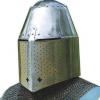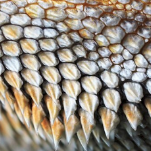All Activity
- Past hour
-
singer 45k Singer 45K25 Roller Foot
Cumberland Highpower replied to nategines's topic in Leather Sewing Machines
I clicked the College Sewing link out of curiosity. Yeah that's about $455! That's close to approaching half of what i sold the 205-64 for...! I've bought some goodies from College Sewing and had pretty good luck so far with "other" prices at least being somewhat affordable. Brexit? Is England the source of Singers in your part of the world? Singers seem to be good machines, but nearly every clone of a Singer I've found made in more modern times was a little better in build quality. Seiko/Pfaff/Adler etc. - Today
-
Development of best servo motor for leather sewing machine
GerryR replied to CowBoyOUTLAW's topic in Leather Sewing Machines
Keep rambling, good info!! -
It's easy to mistype these days, especially with all the autocorrects, I do it all the time! A person could have an oversaturated motor w/stators made from Chinese bean can steel that draws 600W and a quality built Efka or Misubishi that draws 575W and actually have "more" output shaft power put out by the later. When it's a $200 servo vs one a few times more expensive, nobody really seems to care though. I bet all the ROC made clutch motors I have aren't as efficient as my old Belgian and USA made versions, but I don't seem to care either. I'm just rambling on GerryR.
-
Development of best servo motor for leather sewing machine
GerryR replied to CowBoyOUTLAW's topic in Leather Sewing Machines
Yes, but that would defeat the purpose of a softer start, which you are trying to achieve. -
Keep in mind no one machine will do everything. That is why a lot of use have more then one class of machine. If you are going to specialize in that type of work by the proper machine as indicated by @Wizcrafts and @mbnaegle. If you want to do flat work (wallets, belts) buy a flatbed, if you are going to do circular items get a cylinder arm machine. As a note you can sorta kinda turn a cylinder arm machine into flatbed by installing a flatbed table top attachment. If you want to use thread above V207 get a class 441 cylinder arm machine (manual or motorized). Buy Once, Cry Once kgg
-

Development of best servo motor for leather sewing machine
AlZilla replied to CowBoyOUTLAW's topic in Leather Sewing Machines
If you wanted a certain minimum speed, couldn't you just start the gradation at that point? Then have a smoother ride up to max? -
Soon as I read "... reached up ..." parts of my anatomy sucked up into my abdomen. My beard is long enough that I tuck it in my shirt if I'm using a dremel or other spinny thing in my hands.
-
Development of best servo motor for leather sewing machine
GerryR replied to CowBoyOUTLAW's topic in Leather Sewing Machines
Those optical filters are nice, but they defeat the purpose of starting the motor at the so-called required minimum speed, which is probably not necessary in most instances. -
Haven't took a picture yet, but I managed to quite save it. I sanded everything with 500 grit sandpaper. Then I brewed a strong black tea and did a coat of tea, followed closely by a coat of vinegaroon, twice. The colour isn't perfectly uniform but I'm quite happy with it...now I guess oil will suffice to get a good black colour. Don't want to do that on this piece: the scababrd has been made using only period techniques (parchment lining, split wood, linen thread, hide glue...) and I want the colour to match everything. Next batch of vinegaroon is brewing. As far as I understood, also leather type will affect the richness of the colour, isn't it?
-
I'm not an engineer; just a knowledgeable user. Optical speed control is not new technology. I've had volume pedals for my pedal steel guitars from decades ago that used a small light bulb or LED to emit a focused beam against a photo-resistor. The sensor/resistor controlled the signal transfer between the input and output jacks. When backed off, heel down, a small phenolic board blocks the light beam, so there is no output at all, yielding full resistance. As one moves the pedal with his toe down, the phenolic board is brought out of the line of light, gradually increasing the amount hitting the sensor, decreasing its resistance. This results in an extremely smooth transition from zero to the maximum volume that the volume pedal is able to transfer to the amplifier (~95%). My current electronic volume pedal is still optically controlled, but uses a variable density filter instead of a solid piece of board. It has a small amount of amplification so that it doesn't lose any signal at full volume. Fast forward out of the world of pedal steel guitars and into the world of digital servo motors on sewing machines. In 2011 through 2013, our main 441 machine suppliers sold them with a digital motor that had a 45mm pulley. Some started with a jolt at 200 rpm. Others started with a similar jerk at 100 rpm. So. somebody took their motor apart and saw that it was optically controlled, just like my old volume pedals. That person had a good printer and some transparent "paper." He went and printed out some strips that had a varying density of gray ink, smoothly ranging from 100% black to 100% transparent. By playing with the spread of the printed filter, he came up with a simple optical filter that anybody could install inside their motor. He sold them through the forum for a modest fee. I installed one in my Cowboy cb4500, in my buddy's Cobra Class 4, and on a Techsew I acquired a little later. This modification worked 100% as designed. The only thing that caused a variation was if the machine hit a bump in the floor when I moved it to sew a log project (webbing strapping or a long rifle case). It was a simple matter to reposition the filter, which I later glued in place. So, is this new KineDyne motor optically controlled? If so, have you considered using an optical variable density light filter to control the speed? I think I still might have a spare filter in an envelope. Bob Kovar might still have a couple left. We could probably get one to you to experiment with. I'm pretty sure there is a variable density filter in my original digital servo from my cb4500, which is on the floor in a closet. If you try the variable density filter control system and perfect it, then secure it to survive shipping and man-handling, you will be able to offer a motor that smoothly transitions from absolute zero through the top speed as set on the control panel, with good low speed torque from the numerous coils. A side benefit of having a digital servo motor running this slowly is that there seemed to be much less heat being generated. Originally, we felt the heat as we sewed at 5 to 9 stitches per second. It was even running hot at slower speeds due to it starting at 200 rpm. I also disliked the non-linear speed change which ramped up after I pressed down on the pedal. It wasn't an instantaneous change that I preferred. I grew up using clutch motors on sewing machines, and still do on a few of them. I have since moved away from touchy digital servos to the analog motors sold by my Cowboy dealer. They contain brushes and replaceable carbon signal transfer blocks on springs. They reliably start at zero and speed up linearly as I press my toe down; just like my volume pedal on my steel guitar.
-
You have lots of parts. Need a servo motor for it. Does the engraved line on the front of the base say 8345-6 or 8346-6? It has an early Claes cast iron stand almost like the Pfaff Metro Spezial that was a Claes in everything but name. Claes sold machines to Pfaff that Pfaff out their name on it. What questions do you have on the machine? glenn
-
Thanks for the reply! I have come across those sole sidewall stitchers, but they are obviously fairly specialized. I am unsure of how much I could use it for anything else besides what it's intended for. I would love to have one at some point, assuming I continue down the shoemaking path. It's been fairly hard to me to find the best direction to go from my CLSP. I don't know if any single machine will be able to do all of the sewing on my upper assemblies. Seems like that could just be an unfortunate aspect of this style of construction.
-
Then there is the guy that was using an electric drill with a wire brush. He had an itchy spot on his head, so gently reached up with the drill to scratch his head and bumped the trigger. There went a good chunk of his scalp!
-
Mikayla joined the community
-
Hello! I’m hoping to get some guidance on dyeing this iguana leather chest. Yesterday, I applied a layer of black leather dye and it immediately started to swell. I didn’t think I applied so much but as you can see it has swollen in a few spots. Wondering if there is anyway to remedy this?
-
@Dwight - I was also in the Navy, and there's some accidents I saw there that I'd rather forget. Some that I was glad I didn't see was a fella being grabbed by a 5" 54 caliber loading pawl and stuffed into the loading breach. In college, there were all sorts of warnings around the lathe. You had to take a safety class before you were allowed in the building. So, despite all of that, there was a gal who was running the lathe wearing a long pony tail. It was a closed casket funeral. Rotating machinery is terrifying.
-
Thanks Bruce
-
Development of best servo motor for leather sewing machine
GerryR replied to CowBoyOUTLAW's topic in Leather Sewing Machines
Yes, I stated that both motors would generate the same amount of heat and meant power; that is where the heat management comes into play, and like you stated, the choice of materials used. -
Actually there are a few other bits at play, such as the elemental composition of the iron used in the stators. Chinese motors often use some really low quality sheet steel for that. You'll get oversaturation and more heat as a result. I'd gamble an Efka motor generates a good bit less heat to dissipate based on the Watt rating than any of these bargain Amazon servos. Seems like I remember a guy on ebay selling some 4:1 speed reduction bolt on (planetary?) gearboxes for servos. I don't remember too many details other than they were somewhere around $100. Anyone here have one or try one out?
-
Dawn Fiorelli joined the community
-
Landis Model 12 F coming back to life
Dawn Fiorelli replied to FDC's topic in Leather Sewing Machines
My father, a retired Landis K12 machine he’s looking to get rid of. Best offer! -
Development of best servo motor for leather sewing machine
kgg replied to CowBoyOUTLAW's topic in Leather Sewing Machines
Agree. One of the members on the forum has a brushless servo motor that has a fin system moulded right into the small pulley. I am assuming that was done to try and help keep the housing cooler. Lets face it brushless servo motors are designed to last too as long as the warranty period and utilize a design to save on manufacturing costs. I doubt any brushless servo motor will ever come close to lasting as long as the big old heavy clutch motors that weight about 40 lbs. with real metal housings verses about 18 lbs of plastic and aluminum. Sort of like a Zippo lighter lasting a life time verses a BIC lasting a week or two. kgg -
One more thing, I once stepped backwards onto the 8' high set of stairs I just finished taking all the treads and risers off of there was one riser still on that caught my ass, my foot caught the stringer, as I was falling backwards, I was then hanging upside down between the stringers my wife came to the doorway and yelled are yo all right I said I think so jus need to figure out how to get out of this. LOL
-
@fredk re: vintage radios, I have a shed with my collection of valve radios in . Along with parts, valves etc. It was a hobby in another life . Some are / were in working condition, some restored, table models and floor models ,but I have nowhere to display them in my house, no room The one that zapped me is a Philips (I think) single valve wood bee hive cabinet. When unplugged, it put out 95 volts ⚡️ . HS
-
Avoiding accidents #1: if you think Wow, this looks like something I shouldn't do then don't do it. #2 Everyone, well 99%of the time in that 10th of a second before something happens, you know it's going to happen. This is generally when using tools of some kind. like when that wrench just starts to slip and BOOM knuckles #3 rushing something not good or not paying attention, talking to someone while running that unforgivable table saw, you know that 5 horsepower one with the 12" or 14" blade, or that carving gouge you push toward your hand that's holding the wood you should not be holding and you know it!, or the safety glasses you know you should have on while driving cement nails dumbass stuff but we all do it, have done it, or will do it.




.thumb.jpg.6e903dd66163ad5672f00f144058c571.jpg)
